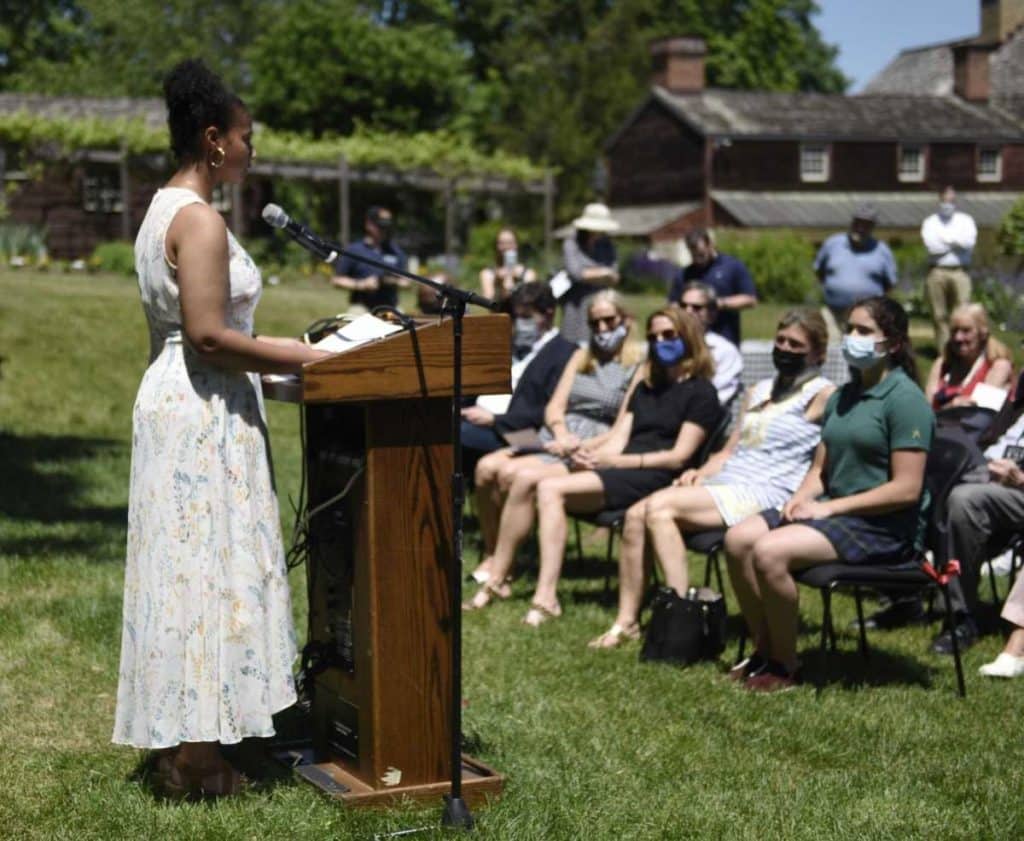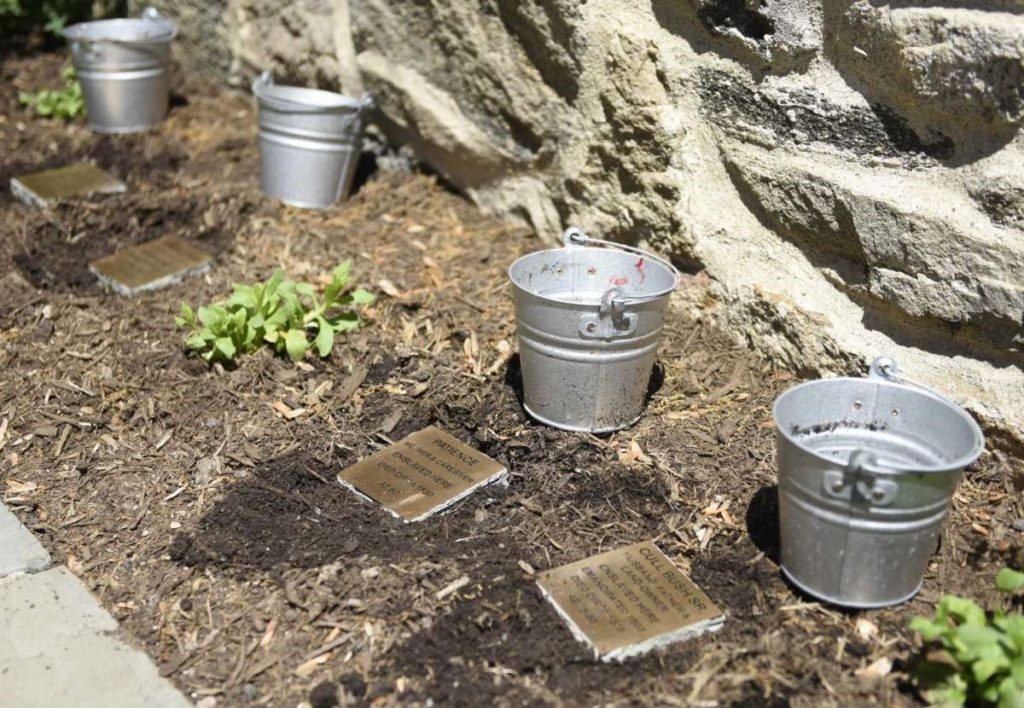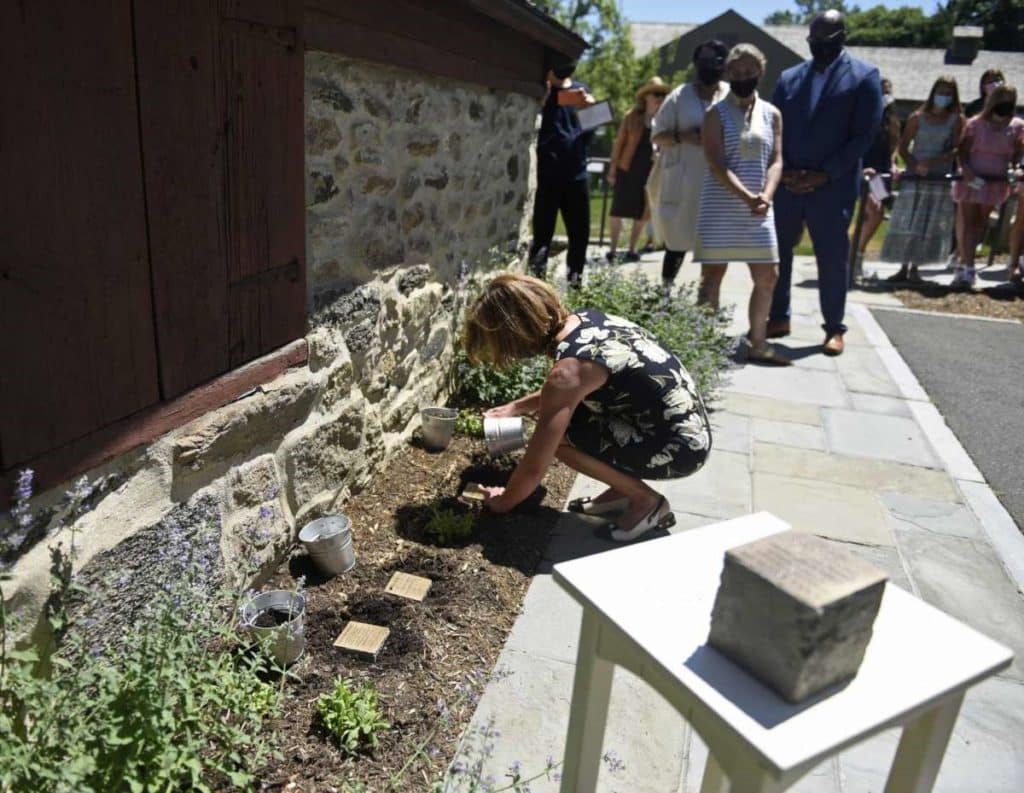By Robert Marchant | Greenwich Time | May 27, 2021
GREENWICH — Slave labor was employed for generations in Greenwich, but there has never been a memorial to the hundreds of enslaved men and women who toiled on farms, built roads and created a prosperous community without any compensation — and little historical recognition.
That changed Thursday, with the placement of “Witness Stones” at the grounds of the Greenwich Historical Society, where some 15 enslaved men and women once worked and lived. A group of students and educators have been researching the lives of four of those enslaved laborers for the past two years, to bring them out of the historical shadows. In a ceremony, four stones with their names on them were laid next to the building where they were believed to have lived and slept.
Debra Mecky, the historical society’s executive director, said the initiative by students at Greenwich Academy and Sacred Heart Greenwich, with assistance by the staff at the historical society, had succeeded in an effort “to bear witness and shine a light on our past.”
The Greenwich research and memorial initiative was tied in with the Witness Stones Project, which has been commemorating the lives of enslaved people in the Northeast with memorial markers beginning in 2017.
The Rev. Thomas Nins, pastor of the First Baptist Church, said community residents he speaks with about the slavery-education project often react with “shock, dismay, ambivalence and denial,” and said many people are unaware that the institution of slavery has a long history in northern states. Slavery was not fully abolished in Connecticut until 1848.
“Some truths are hard to accept, some realities we would rather forget,” said Nins. “This truth, that there were slaves in the town of Greenwich, is not something everyone embraces, and some people would rather not deal with.”
The students researchers and educators performed a valuable service, he said.
“I want to commend those who were part of this project for being courageous,” Nins said. “For taking the necessary step, to say, ‘There is another truth, there is another reality that has existed, and we’re going to share it.’”
It is important to “give a voice to the voiceless, and providing names to the nameless,” and research into a dark chapter of the town’s past will be a benefit, he said. “We have learned from it, hopefully, and we will be better for it going into the future,” the reverend said.
According to research by the historical society, there were about 300 enslaved people in Greenwich in 18th and 19th centuries. The local students researched the lives of Cull Bush Sr. and his domestic partner, Patience, as well as Candice Bush, and her daughter Hester Mead, poring through old wills, census forms and death certificates.
Students gave brief presentations about the four people they had researched — describing how young Candice was put to work in the kitchen of the Bush family homestead at the age of 10, and how Patience raised six children, all leading hard lives.
Clare Junius, a Sacred Heart seventh-grader, said her research “opened up my eyes to the personal tragedy of slavery.” She said she was struck by how little documentation exists on the enslaved laborers, how they had been erased from history, even as the lives of the white families for whom they toiled were recorded in copious detail.


Lily Broughton, another Sacred Heart student, said the poor living conditions that the enslaved families endured struck her. “They slept in the attic and didn’t have much food,” she said.
“Many of the millions of enslaved people who were forced to work for their owners weren’t even recognized as humans, but property or objects,” said Sacred Heart student Lillie Foster. She noted that Cull Bush did not have a gravestone erected after his death sometime around 1845. The Witness Stone placed in his memory is a way to restore his humanity, and others like him, she said.
“They deserved to be recognized as humans. … We can now make sure that almost every enslaved person is remembered, as we are doing today,” she said.
Hazel Carrion of Sacred Heart, who researched the life of Candice Bush, said she was impressed by her determination, creating a life for herself after she was given freedom. “Her story is an example of how difficult a life it was for African-Americans for centuries,” Carrion said.
Ana Gonzalez, a Greenwich Academy high school student, described the life of Hester Mead at the ceremony. She said she was thankful that the staff at the historical society had preserved records and encouraged the research, “or it is very likely that Hester’s story and many others like her would have been forgotten.” She said a greater awareness of Hester Mead and her family “gave a better understanding of our nation’s history.”
First Selectman Fred Camillo said he said he hoped that the recognition of the enslaved people in Greenwich would gain greater recognition. “It’s something that should stay on our minds whenever we talk about the history of Greenwich, that this is a part of it,” Camillo said.
The four small stones, cast from concrete, hold a bronze plaque that provides the names of the four people and a brief description of their lives. Students will continue the research project on the 11 other slave laborers who lived at the Bush-Holley homestead, which became the campus of the historical society.

